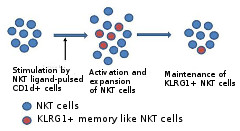
In research published in the Proceedings of the National Academy of Sciences, researchers from the RIKEN Center for Integrative Medical Science have discovered an intriguing new role played by a subset of invariant natural killer T cells—a type of immune cell that seems to play an intermediate role between the adaptive and innate immune systems.
In the past, it was commonly believed that immune cells could be clearly divided into innate immune cells, which respond to attacks in a non-specific way, and adaptive immune cells, which learn to recognize new antigens and can then gain the ability to react to later attacks in a rapid way. However, in recent years it has become clear that these distinctions are not always so easy to make.
The RIKEN researchers found that KLRG1+ iNKT cells, a subset of invariant natural killer T cells that were previously considered part of the innate response, can remain in the lung for a long time—up to nine months—following exposure to an antigen and are capable of promoting a rapid, secondary response to a threat even four months after the initial injection of NKT cell ligand-loaded CD1d+ cells, such as dendritic cells, in a manner that is reminiscent of the behavior of memory natural killer and T cells. It was previously believed that iNKT cells were short lived and would rapidly disappear from tissues and not be capable of leading a secondary response. Here, the researchers found that the cells can be re-activated following exposure to the same antigen, meaning that they have characteristics of adaptive immunity.
To carry out the study, the group identified a specific marker of KLRG1 using gene array technology and characterized the KLRG1+iNKT cells with flow cytometry, ELISA and real-time PCR, and also examined the antitumor effect of the cells using a lung metastasis model.
According to Shin-ichiro Fujii, who led the study, "I am very excited by these results. This work could lead to a paradigm shift in our understanding of iNKT cells, as we have found that these iNKT cells are clearly part of the innate immunity system but still have memory cell-like characteristics."
"We are currently collaborating with hospitals to study the use of NKT cell therapy in patients with lung cancer or head and neck cancers," he said, "and further investigation of these different populations could help us to choose better types of NKT cells to use in the clinic."
